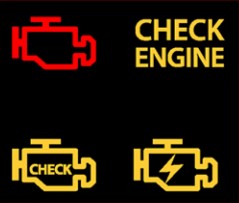
Dashboard Warning Lights: What They Mean and What to Do
Dashboard warning lights are essential for monitoring your vehicle’s condition. They provide vital information about various systems in your car. Recognizing these lights and understanding what they signify can help prevent breakdowns, ensure your safety, and keep your vehicle running smoothly. Here’s a guide to some common dashboard warning lights you might encounter.
1. Check Engine Light
The check engine light, often represented by an engine icon or the word “CHECK,” is one of the most common warning lights. It indicates that your vehicle’s onboard diagnostics system has detected an issue. The problem could range from a loose gas cap to more serious engine troubles.

What to Do: If the light is steady, schedule a service appointment to diagnose the issue. If the light is flashing, it indicates a severe problem that requires immediate attention.
2. Brake/ABS Warning Light
This light, typically shown as an exclamation mark inside a circle or the letters “ABS,” indicates a problem with the braking system or the Anti-lock Braking System (ABS). It could be as simple as the parking brake being engaged or a more serious issue like low brake fluid or a malfunctioning ABS system.

What to Do: Check if the parking brake is engaged. If the light remains on, check the brake fluid level and consult a mechanic if needed.
3. Steering Warning Light
The steering wheel icon, often accompanied by an exclamation mark, suggests an issue with the power steering system. It could mean that the power steering fluid is low or that there’s a malfunction in the electronic power steering system.

What to Do: Check the power steering fluid level. If the problem persists, seek professional assistance to avoid difficulty in steering.
4. Airbag Supplemental Restraint System (SRS) Warning Light
The SRS warning light, usually depicted as an airbag, indicates a problem with the airbag system. This could mean that the airbags might not deploy correctly in the event of a collision.

What to Do: It’s crucial to have this checked by a professional, as it affects the safety systems in your vehicle.
5. Hood/Trunk Open Warning Light
This light is represented by an open hood or trunk icon and indicates that the hood or trunk is not properly closed.

What to Do: Check that the hood or trunk is securely closed to ensure it does not open while driving, which can be a safety hazard.
6. Door Ajar Warning Light
A car with open doors icon indicates that one or more doors are not fully closed.

What to Do: Check all doors to ensure they are properly closed before driving.
7. Cooling System Warning Light
This light, often represented as a thermometer in water, indicates that the engine is overheating or there’s an issue with the coolant system.

What to Do: Stop the vehicle immediately to prevent engine damage. Check the coolant level and consult a mechanic if necessary.
8. Oil Level/Pressure Warning Light
This light, often depicted as an oil can, indicates low oil pressure or low oil levels, which can cause severe engine damage if not addressed.

What to Do: Check the oil level and top up if necessary. If the light remains on, seek immediate professional assistance.
Conclusion
Understanding dashboard warning lights is crucial for maintaining vehicle safety and performance. Ignoring these warnings can result in expensive repairs or hazardous situations. Always consult your vehicle’s owner’s manual for specific information and guidance on addressing these warnings. If you’re ever uncertain, seeking advice from a professional mechanic is the best action to take.
For more information contact our sales team.






